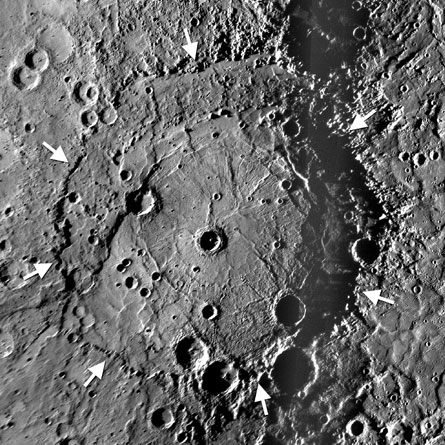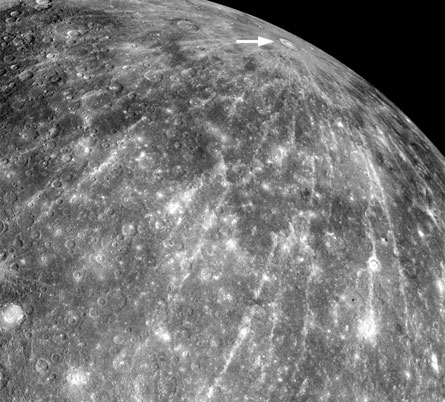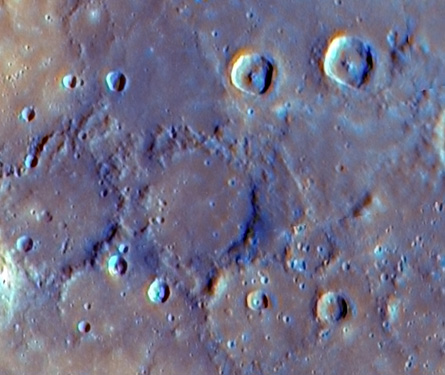Mercury is on the rise.



The solar system’s neglected stepchild until recently, the planet has now been scrutinized twice at close range by the MESSENGER spacecraft. The craft’s most recent flyby, on October 6, 2008, has revealed that Mercury had an intense period of volcanic activity early in its history, with at least 40 percent of the surface now paved by lava flows.
Images taken during that flyby have also uncovered the second largest crater known on Mercury. The ancient, roughly 715-kilometer–wide basin, dubbed Rembrandt, is only partially filled with volcanic material. As a result, MESSENGER saw fracturelike deformations, some of which were caused by contraction of the planet as it cooled.
The craft also documented a surprisingly strong link between the sun’s magnetic field and that of the planet. MESSENGER team leader Sean Solomon of the Carnegie Institution for Science in Washington, D.C., and his colleagues detail the latest findings in four reports in the May 1 Science.
During MESSENGER’s first flyby (SN: 1/26/08, p. 51), on January 14, 2008, the magnetic field carried by the solar wind aligned with the magnetic field around Mercury, and the craft measured relatively little magnetic activity. But during the October flyby, the solar wind’s magnetic field opposed that of the planet.
In that second configuration, the two fields connected in a magnetic handshake that dumped about 10 times more energy from the solar wind into Mercury’s magnetosphere than astronomers have observed in past interactions between the wind and Earth’s magnetosphere. The magnetosphere is the region around a planet where its magnetic field dominates. The magnetic handshake generated giant waves that set Mercury magnetosphere pulsating with magnetic twisters dancing on its surface, writes Karl-Heinz Glassmeier of the Technical University of Braunschweig and the Max Planck Institute for Solar System Research in Katlenburg-Lindau in Germany in a commentary in the same issue of Science.
Combining observations of Mercury’s crust recorded by MESSENGER and those recorded by Mariner 10 in the 1970s reveals that at least 15 percent of the planet’s surface is covered by a relatively blue, dim compound. Most of it is concentrated in craters and adjacent regions splattered with material excavated from craters. Solomon says the most likely candidate is a titanium-rich oxide that originated one to 10 kilometers below the surface and was exposed when space debris bombarded the planet.
The presence of titanium oxide would suggest that during Mercury’s first 100 million years or so, while the planet was still forming, it was hot enough to generate a magma ocean, with much of the surface and the interior liquid, comments Linda Elkins-Tanton of MIT. Titanium oxide would have been one of the last compounds to solidify, and it might have remained just beneath the surface.
“There really isn’t another very good way to make a very rich titanium layer without a magma ocean,” she says.
Evidence over the last few years suggests that Earth had at least a partial magma ocean during its early years. Understanding whether other terrestrial planets had similar starting conditions may ultimately help explain why Earth’s outermost layer developed a patchwork of moving plates while other planets may not. Researchers believe that the system of recycling crust, known as plate tectonics, may have helped make Earth habitable, notes Elkins-Tanton. In addition, knowing how common it is for young terrestrial planets to form a magma ocean may be an important clue in identifying habitable Earthlike planets beyond the solar system, she adds.
“The information [the MESSENGER researchers] are discovering is not just teaching us about Mercury but about planet formation in general,” Elkins-Tanton says.
The craft will fly past Mercury one last time, on September 29, in preparation for settling into orbit about the planet for one Earth-year, beginning in March 2011.







